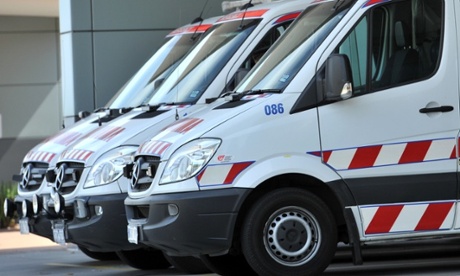Victorian study finds no increase in crystal methamphetamine use, despite politicians’ claims of an ‘epidemic’

There is no ice epidemic sweeping Australia, despite what politicians and police might say, a report led by one of the country’s leading drug researchers has found.
Paul Dietze, from the Burnet Institute in Melbourne, said there had been a dramatic increase in the purity of crystal methamphetamine, known as ice, which was increasing the level of damage caused by the drug.
But the number of people using methamphetamine had remained stable, he said.
“The perception of an ice epidemic is being driven by the experience of harms people are seeing, particularly noted by an increase in ambulance attendances and hospitalisations,” Dietze said. “What we are arguing is that this is probably due to the changes in purity, not an increase in users.”
This situation did not fit the definition of an epidemic, he said, because there has been no surge in use.
The researchers combined data from a Burnet study on injecting drug use with Victoria police forensic services statistics, and found the purity of ice had increased from 21% to 64% between 2009 and 2013.
Yet people were still buying and consuming the same quantity. And Dietze said a forthcoming study would show use had remained stable across three different surveillance systems since 2008.
The research, published in the medical journal Addiction, looked at Victorian data, but Dietze said he suspected the situation in other states was similar.
“No other state tests the forensic samples in ways Victoria does, so we don’t have a uniform picture of what is happening, but all evidence from national studies suggests stable use across the country,” he said.
A co-author of the study, Brendan Quinn, was due to present the findings at the Australian Drugs Conference in Melbourne on Tuesday.
“Our data suggests that the people are paying a little more for the typical amount they’ve been using,” Quinn said. “However, the purity of what they buy is dramatically higher than a few years ago and if you are using a typical amount but the drug has a much higher strength, this can potentially lead to harm.”
Their finding echoes those in a report on ice use recently tabled in the Victorian parliament. But across the country, politicians and police are describing the problem in epidemic terms.
Last month, the NSW police commissioner, Andrew Scipione, told the ABC: “This is an epidemic, but it’s not an epidemic that’s exclusively Australian, this is sweeping the world, this whole ice trade issue is one that just continues to grow.”
A national task force was needed to tackle the problem, he said.
Victoria’s opposition spokesman for police, Wade Noonan, said that if elected on 29 November Labor would introduce the state’s first Ice Action Plan, including $15m for new drug and alcohol buses and $500,000 to set up community action groups.
“The ice epidemic is devastating our communities and Labor will work with police, experts and the community to find a solution,” Noonan said.
Dietze said the best approach to minimise harm from ice was to better equip frontline emergency services workers, who frequently came into contact with those affected by the drug, rather than taking a broad, population-wide approach.
There is no equivalent to methadone treatment for ice addicts, who can take months to fully recover.
